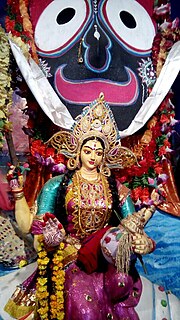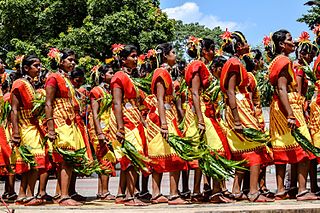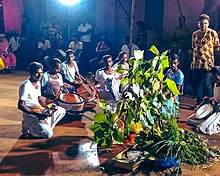
Vijayadashami, also known as Dussehra, Dasara or Dashain, is a major Hindu festival celebrated at the end of Navaratri every year. It is observed on the tenth day in the Hindu calendar month of Ashvin, the seventh month of the Hindu Luni-Solar Calendar, which typically falls in the Gregorian months of September and October.

Durga Puja, also known as Durgotsava or Sharodotsava, is an annual Hindu festival originating in the Indian subcontinent which reveres and pays homage to the Hindu goddess Durga and is also celebrated because of Durga's victory over Mahishasur. It is particularly popular and traditionally celebrated in the Indian states of West Bengal, Bihar, Assam, Odisha, Tripura, and the country of Bangladesh. The festival is observed in the Indian calendar month of Ashwin, which corresponds to September–October in the Gregorian calendar. Durga Puja, is a ten-day festival, of which the last five are of the most significance. The puja is performed in homes and public, the latter featuring a temporary stage and structural decorations. The festival is also marked by scripture recitations, performance arts, revelry, gift-giving, family visits, feasting, and public processions. Durga puja is an important festival in the Shaktism tradition of Hinduism. Durga puja in Kolkata has been inscribed on the Intangible cultural heritage list of UNESCO in December of 2021.

Chhath is an ancient Hindu festival historically native to southern Nepal and eastern India, more specifically, the Indian state of Bihar along with Uttar Pradesh and Jharkhand, and Madhesh in Nepal. It has become popular with the Pahari people native to the Himalayas in Nepal in the recent years, due to the influence of the Madheshi people from southern Nepal near the border with India. Prayers during Chhath puja are dedicated to the solar deity, Surya, to show gratitude and thankfulness for bestowing the bounties of life on earth and to request that certain wishes be granted.

Naga Panchami is a day of traditional worship of Nag or snakes observed by Hindus, Jains, and Buddhists throughout India, Nepal, and other countries where Hindu, Jain, and Buddhist adherents live. The worship is offered on the fifth day of bright half of lunar month of Shravana (July/August), according to the Hindu calendar. Some Indian states, such as Karnataka, Rajasthan and Gujarat, celebrate Naga Panchami on the dark half of the same month. As part of the festivities, a Naga or serpent deity made of silver, stone, wood, or a painting of snakes is given a reverential bath with milk and their blessings are sought for the welfare of the family. Live snakes, especially cobras, are also worshipped on this day, especially with offerings of milk and generally with the assistance of a snake charmer.

Sharad Purnima is a harvest festival celebrated on the full moon day of the Hindu lunar month of Ashvin, marking the end of the monsoon season. On this auspicious day, many divine pairs like Radha Krishna, Shiva Parvati and Lakshmi Narayan are worshipped along with the moon and are offered flowers and kheer. Deities in temples are usually dressed in white color signifying the brightness of moon. Many people observe full day fasting on this day.

Aadi Perukku commonly known as the Aadi monsoon festival is South Indian cultural festival celebrated on the 18th day of the Tamil month of Adi. The festival pays tribute to water's life-sustaining properties. For the blessing of mankind with peace, prosperity and happiness, nature worship in the form of Amman deities are organized to shower Nature's bountiful grace on human beings.
This article lists the traditional festivals and other cultural events in the Odisha region of India. Odisha celebrates 13 festivals in 12 months as the saying goes Bāra Māsare Tera Parba.

Kirat Mundum, also known as Kiratism, or Kirati Mundum, is a Folk religion that is indigenous to the Kirati ethnic groups of Nepal, Darjeeling and Sikkim, majorly practiced by Yakkha, Limbu, Sunuwar, Rai, Thami, Jirel, Hayu and Surel peoples in the north-eastern Indo subcontinent. The practice is also known as Kirat Veda, Kirat-Ko Veda or Kirat Ko Ved. According to some scholars, such as Tom Woodhatch, it is shamanism, animistic religion or blend of shamanism, animism, and Shaivism. It is practiced by about 3.1% of the Nepali population. Its Limbu language slogan is,.

Lakshmi Puja, is a Hindu occasion for the veneration of Lakshmi, the goddess of prosperity and the supreme goddess of Vaishnavism. The occasion falls on the amavasya in the Vikram Samvat Hindu calendar month of Kartik, on the third day of Deepavali. It is considered to be the main festive day of Deepavali. In Assam, Bengal, and Odisha, this puja is celebrated 5 days after Vijaya Dashami.

Nuakhai or Navakhai or is an agricultural festival mainly observed by people of Western Odisha and Southern Chhattisgarh in India. Nuakhai is observed to welcome the new rice of the season. According to the calendar it is observed on panchami tithi of the lunar fortnight of the month of Bhadrapada or Bhadraba (August–September), the day after the Ganesh Chaturthi festival. This is the most important social festival of Western Odisha and adjoining areas of Simdega in Jharkhand, where the culture of Western Odisha is much predominant because there are so many things learn about agriculture with Human behavior also, nuakhai is very big festival and a unique festival also that's why every Indian knowing to Nuakhai History if you love any food then.
Vishwakarma Jayanti is a day of celebration for Vishwakarma, a Hindu god, the divine architect.

Mahasu Devta Temple, is located on the Tuini-Mori road at Hanol, Dehradun district, Uttarakhand,India. The temple is dedicated to Mahasu Devta. Lord Mahasu is the chief deity of this area and is worshipped in Mahasu Devta Temple by the people of Hanol and nearby villages of Uttarakhand and Himachal Pradesh state of India. It is the ancient temple of Mahasu Devta built in the 9th century. The temple was constructed in Kath-Kuni or Koti-Banal style of architecture. It is included in the Archaeological Survey of India list of the ancient temple in the Dehradun circle, Uttarakhand.

Bhumij is a Munda ethnic group of India. They primarily live in the Indian states of West Bengal, Odisha, and Jharkhand, mostly in the old Singhbhum district. Also in states like Bihar and Assam. There is also a sizeable population found in Bangladesh. Bhumijas speak the Bhumij language, an Austroasiatic language, and use Ol Onal script for writing.

Navaratri is a biannual and one of the most revered Hindu festivals observed in the honour of Mother Goddess Durga. It spans over nine nights, first in the month of Chaitra and again in the month of Sharada. It is observed for different reasons and celebrated differently in various parts of the Hindu Indian cultural sphere. Theoretically, there are four seasonal Navaratri. However, in practice, it is the post-monsoon autumn festival called Sharada Navaratri. The festival is celebrated in the bright half of the Hindu calendar month Ashvin, which typically falls in the Gregorian months of September and October. It takes place at the same time as the Nine Emperor Gods Festival.
Nyokum is a festival celebrated by the Nyishi tribe of the Indian state of Arunachal Pradesh. The Word Nyokum has been derived from the combination of two words - Nyok means land (earth) and Kum means collectiveness or togetherness. Therefore, the Nyokum festival may very well be interpreted as inviting all the Gods and Goddesses of the universe, with the Nyokum Goddess as the principal deity, to a particular venue at a particular time. The festival is commonly celebrated by the people from all class and walk of life for better productivity, prosperity and happiness of all human beings.

Karma dance or Karma Naach is a traditional dance of central and Eastern India annually performed during the karma festival. Karma is a famous autumnal festival, it starts from the 11th day of the bright fortnight of the month of Bhadrab. It is performed in State of Chhattisgarh, Jharkhand, Madhya Pradesh, Odisha and West Bengal. Karma means 'fate'.
Here is a list of glossary of Culture of India in alphabetical order:

Bandna is a agriculture-oriented festival of the Kurmali ethnolinguistic and other related communities, in which domestic cattle and agriculture appliances are worshiped. The festival mostly observed in the state of Jharkhand, West Bengal, Odisha and Assam, and celebrated annually as per Kudmali calendar in the month of Amavashya of Kartik
The Indian state of Jharkhand is located in the eastern part of the country and is known for its vivid culture,distinct paintings, traditions and festivals.

Sarhul is a spring festival in the Indian state of Jharkhand. The festival is celebrated for three days, from the 3rd day of Chaitra month in Sukla Paksh to Chaitra Purnima. In the festival, the village priest Pahan offers sacrifice of flowers, fruit, vermilion, rooster and tapan (liquor) in Sarna to deities for good fortune of the village. Then the locals dance holding flowers of the sal tree. It is a symbol of commencement of the new year. According to the tradition, it also symbolises marriage between the Earth and the Sun. It is an important festival observed by the Oraons and Sadan. Among Kurukh it is known as Khaddi in Kurukh.
















